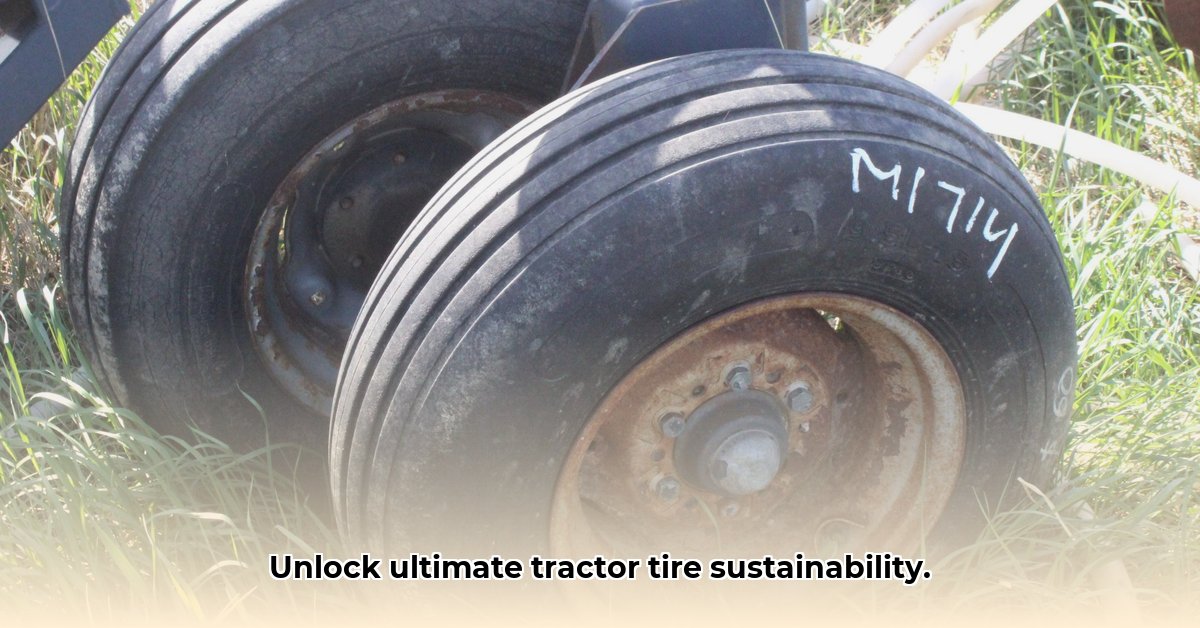
9.5x15 Tractor Tires: A Sustainability Deep Dive
Choosing the right tractor tires is a multifaceted decision impacting both farm productivity and environmental responsibility. This article delves into the sustainability aspects of 9.5x15 tractor tires, a common size frequently used in agricultural operations. We'll examine technical specifications, explore the environmental footprint, and offer actionable recommendations for farmers and manufacturers seeking more sustainable practices. For more on tractor tire options, see flotation tire options.
Understanding the 9.5x15 Tractor Tire Market
The agricultural sector is increasingly focused on environmental stewardship. Farmers are actively seeking equipment that minimizes their environmental impact, and tire selection plays a crucial role. 9.5x15 tractor tires, while widely available from various manufacturers (e.g., Carlisle), lack comprehensive sustainability data. This data gap hinders informed decision-making regarding environmental responsibility. Commonly touted features like 8-ply construction emphasize durability and longevity, directly impacting downtime. However, the long-term environmental implications of these durable tires remain largely unquantified.
The Sustainability Puzzle: Addressing the Data Gap
Despite the prevalence of 9.5x15 tractor tires, comprehensive data on their complete environmental lifecycle – from raw material extraction to end-of-life disposal – is surprisingly scarce. This knowledge gap significantly limits informed decision-making. While manufacturers offer various models, critical information regarding recycled rubber content, manufacturing carbon footprint, and end-of-life management remains opaque. This lack of transparency prevents a true assessment of their environmental impact.
Essential Data for Sustainable Choices
To make truly informed, sustainable choices, we urgently need comprehensive data across several key areas:
Life Cycle Assessments (LCAs): Independent LCAs for various brands of 9.5x15 tires are vital. These assessments (a detailed analysis of a product's environmental journey from cradle to grave) would evaluate material use, manufacturing, transport, use, and disposal. This would allow for accurate comparisons and informed decision making.
Material Transparency: Manufacturers must openly disclose the percentages of recycled rubber and other sustainable materials used in their tires. This transparency allows farmers to make informed comparisons and choose eco-friendlier options.
Performance vs. Efficiency: Rigorous testing is needed to quantify the relationship between different tire types and fuel economy. This data empowers farmers to make optimal choices that minimize both costs and environmental impact.
Durability and Longevity: Comprehensive wear testing is needed to determine which tire brands exhibit the longest lifespan, thus minimizing waste and replacements. This directly translates to both cost savings and a reduced environmental burden.
Stakeholder Perspectives and Collaborative Action
Addressing the sustainability challenge requires a collaborative effort involving multiple stakeholders.
| Stakeholder | Short-Term Actions | Long-Term Vision |
|---|---|---|
| Tire Manufacturers | Publish comprehensive LCAs; enhance process transparency. | Develop tires using maximal sustainable materials; establish closed-loop recycling systems. |
| Farmers/Agribusiness | Request LCA data from manufacturers; prioritize transparency in purchasing decisions. | Advocate for standardized sustainability labeling; actively seek fuel-efficient tire options. |
| Government Agencies | Fund LCA research; incentivize sustainable tire production. | Implement lifecycle reporting mandates; invest in research into sustainable materials and technologies. |
| Consumers | Research tire lifespan and sustainability before purchasing; seek out transparent information. | Support companies committed to environmental responsibility and sustainable practices. |
How to Choose Sustainable 9.5L-15 Tractor Tires
Key Takeaways:
- Improved traction directly correlates with better fuel economy, reducing environmental impact.
- Durable tires reduce waste through fewer replacements, minimizing landfill burden.
- Soil compaction significantly impacts soil health; proper tire pressure is crucial for mitigation.
- When selecting tires, tailor your choice to specific farm needs including size, terrain, and workload.
- Sustainable tire selection necessitates evaluation of factors like lifespan, fuel efficiency and soil health.
Choosing Sustainable 9.5L-15 Tractor Tires: A Step-by-Step Guide
Assess Farm-Specific Needs: Consider farm size, soil type, typical workloads, and climate conditions to determine appropriate tire specifications.
Compare Tire Specifications: Examine ply rating, dimensions, and construction. Robust construction generally correlates with greater durability.
Prioritize Fuel Efficiency: Select tires known for good traction to minimize fuel consumption and reduce your carbon footprint. Look for independently verified performance data.
Minimize Soil Compaction: Consult relevant resources to determine proper tire pressure for your conditions. Accurate pressure monitoring is crucial.
Consider Tire Lifespan: A longer-lasting tire reduces the need for frequent replacement, aligning with sustainable practices.
Research Manufacturers' Sustainability Commitments: Investigate manufacturers' dedication to sustainability initiatives, including eco-friendly materials and manufacturing processes.
Mitigating Soil Compaction
Soil compaction significantly affects soil health. Here are mitigation strategies:
- Maintain Correct Tire Inflation: Under-inflation increases compaction, while over-inflation damages tires and soil. Accurate pressure monitoring using a gauge is essential.
- Implement Controlled Traffic Farming: Plan routes to minimize repeated passes in the same areas.
- Utilize Cover Crops: Cover crops improve soil structure and resilience to compaction.
The Future of Sustainable Tractor Tires
The development of tires utilizing recycled and sustainable materials is a crucial area of ongoing research and development. Continued innovation in tire design and manufacturing is necessary to create more environmentally responsible products with longer lifespans, ultimately contributing to a more sustainable future for agriculture.